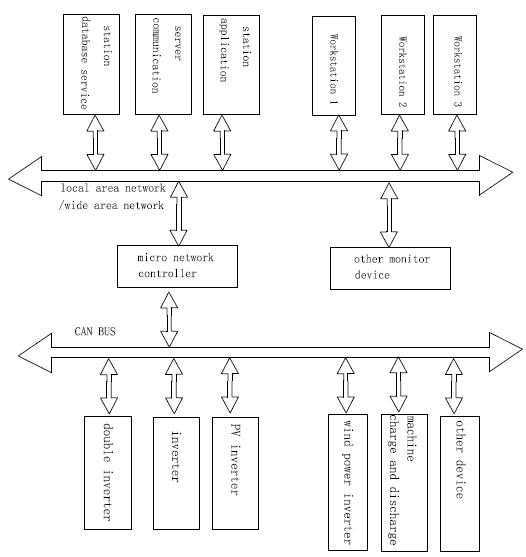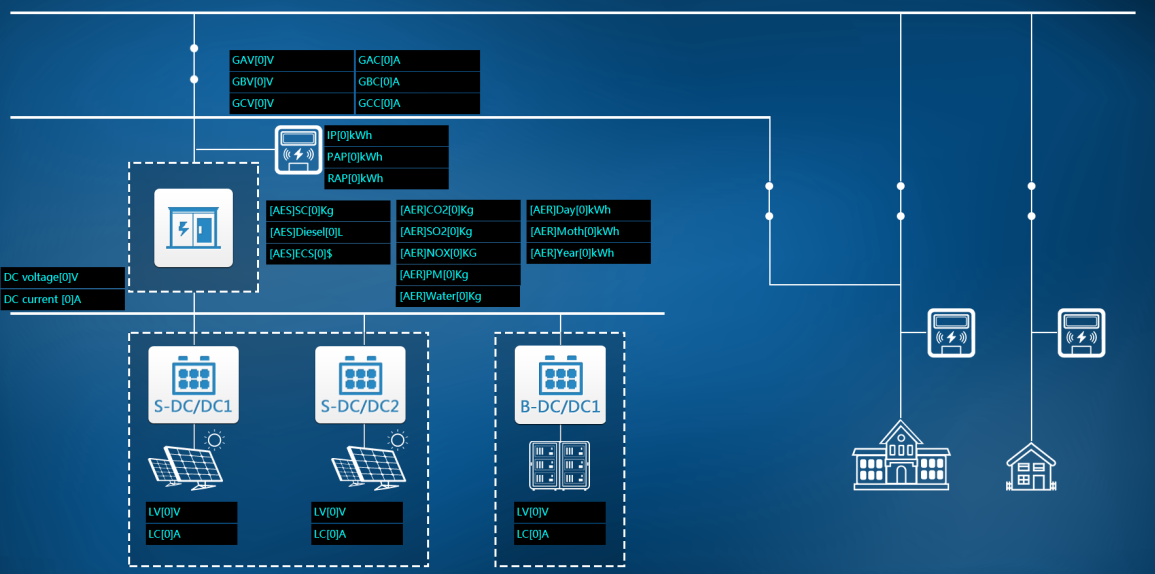Micro network monitoring system topology:


Monitoring software features
1)Communication access and management
● Powerful communication access/conversion capabilities:
Include different communication media such as Ethernet, RS232/485, and CAN.
● Good openness:
Support multiple channels and multiple telecontrol protocols to run simultaneously. Each channel can flexibly configure protocols and access any related control devices.
Provide a variety of protocols such as: IEC60870-5-101, IEC60870-5-104, CDT93, modbus, etc.;
The protocol is loaded as dynamic library and adding/customizing a new protocol or upgrading a protocol can be facilitated conveniently.
● Good scalability:
The number and type of accessed devices into the system can be flexibly expanded, making it easy to implement expansion and upgrade of storage power stations and providing users with ease for step-by-step implementation of energy storage power stations.
2)Supervisory Control And Data Acquisition (SCADA)
● Real-time data collection and processing
● Powerful real-time database processing ability
● Configuration screen generation and real-time data display
● Control operation and locking function
● Statistics and calculation function
● Electric energy processing and billing
● Alarm processing
● Message monitoring
● Report generation and printing
● Interface with other devices or systems
● Others
3)Support functions for secondary development of advanced control strategies
● Database model customization:
Advanced control strategy application software can customize the required data model and load it into the real-time historical database to provide data for advanced control strategy applications.
● Real-time database interface:
Object-oriented real-time historical library interface API is adopted. Advanced application software can access library data through the API and the system provides related screen, alarm information and other services.
● Network communication interface:
The network communication interface provides application-level communication services, allowing transparent messaging between any applications. With this service, advanced application software can execute advanced applications through the provided services.
4)Information control flow
● BMS access
BMS generally has CAN or RS485 communication interface and communication access devices can be configured as required. Generally, the information uploaded by BMS includes:
voltage and temperature of a single cell;
battery current, leakage current;
various fault alarm signals and protection action signals;
battery SOC and other real-time information.
BMS signals can be directly sent to the monitoring system. Alternatively they can be connected to a micro-grid controller or PCS first and forwarded by the micro-grid controller or PCS to the monitoring system. The operation of the BMS is not dependent on the monitoring system.
● PCS access
A PCS generally has CAN, RS485 or Ethernet communication interface, and the interactive information includes:
Switching value: mainly refers to the status of DC and AC side contactors and circuit breakers. It can also refers to the operating mode (grid-connected mode, islanded mode, charging, discharging, standby, etc.).
Analog quantity: DC side voltage, current, power, etc.; AC side three-phase voltage, current, active power, reactive power, etc.
Non-electrical quantity: IGBT module temperature, reactor temperature, etc.
Operation information: various protection action signals and event alarm signals of the converter.
Operation mode switching: include the transition between the isolated network/grid-connected network; charging/discharging transition.
Running constants setting: include charging/discharging current value; depth of discharge; various protection value settings.
Although various setting values and parameters of PCS can be set in advance and no control from the monitoring system is required during operation, in order to implement the application of the advanced control strategy, real-time information interaction among PCS, monitoring system, and remote devices should be considered.
5)Operation mode
The monitoring system supports remote and local operation modes. In remote operation mode, the local control strategy of the monitoring system is blocked, and the remote device can receive scheduling commands forwarded by the monitoring system. The energy storage system can be directly controlled through a micro-grid controller or PCS. In local operation mode, PCS is controlled by control strategy software or services operated in the monitoring system.